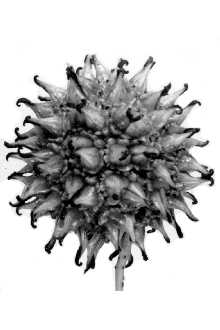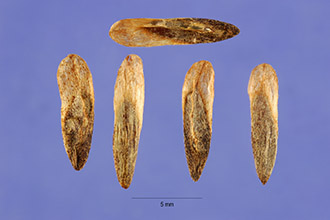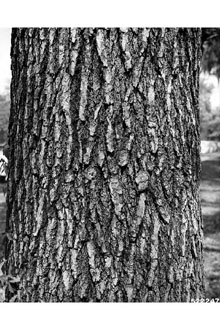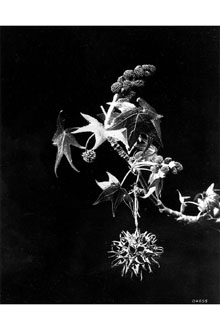Sweetgum
Scientific Name: Liquidambar styraciflua L.

| General Information | |
|---|---|
| Usda Symbol | LIST2 |
| Group | Dicot |
| Life Cycle | Perennial |
| Growth Habits | Tree |
| Native Locations | LIST2 |
Plant Guide
Uses
Ethnobotanic: The sweetgum tree was used by the Cherokee, Choctaw, Koasati, Rappahannock and other Native American tribes for various purposes. The hardened gum, or rosin from the tree was used as chewing gum. A piece of the bark was knocked from the tree. After one week, the sap from the wound was hardened and could be collected and used for chewing gum. Tea was made from both the fruits and the bark. The hardened sap was rolled up and then placed in a dog’s nose to treat distemper. A salve was made by mixing the plant with animal tallow for application to wounds, cuts, sores, bruises, and ulcers. The plant was boiled until a scum rose to the top. This scum was then mixed with the roots of Obolaria virginica and used as a dressing for cuts and bruises. The roots were boiled into a strong tea to treat skin sores that were possibly caused by small worms under the skin. A “drawing plaster” was made from the gum. Ten to a dozen drops of the sap were taken before meals to reduce fevers. The sap and inner bark were used to treat diarrhea and dysentery. The bark was used to make an infusion that was used as a sedative for nervous patients and for patients who were well in the day but sick during the night. The plant was used to treat colic, internal diseases and to “comfort the heart.” Wildlife: Goldfinches, purplefinches, mallard ducks, bobwhite quails, Carolina chickadees, yellow-bellied sapsuckers, white-throated sparrows, towhees, Carolina wrens, squirrels, and chipmunks eat the seeds of sweetgum trees. Beavers use the wood for constructing dams. Other: Liquidambars are valued for their timber and for the aromatic sap, called styrax. The timber provides pulp, veneer and lumber. The wood is used in cabinetry, home interiors, boxes and utensils. The balsamic sap is used as an ingredient in both medicine and perfume. USDA, NRCS, National Plant Materials Center
Status
Please consult the PLANTS Web site and your State Department of Natural Resources for this plant’s current status (e.g. threatened or endangered species, state noxious status, and wetland indicator values).
Description
General: Sweetgum is a deciduous tree that is a member of the Hamamelidaceae, or witch-hazel family. It is named after the sweet balsamic sap which, when exposed, hardens into a fragrant gum. The trees can reach 30 to 40 meters in height and spread from 15 to 20 meters. The mature bark is rough, deeply furrowed and grayish brown. Young twigs are rusty red and frequently develop wings of corky bark. The star-shaped leaves, somewhat resemble maple leaves, except that they are arranged alternately instead of opposite. The leaves are 18 cm wide with long, thin petioles (6-15mm). Actively growing leaves are fragrant when crushed. They are palmate in shape with five to seven lobes and saw-toothed margins. Glossy-green in summer, the leaves turn bright yellow to deep red in the fall. The undersides of the leaves are pale green with a coating of fine white hairs. The small, greenish inconspicuous flowers have no true petals. The woody, ball-shaped, pendulous, burr-like fruits (3-4 cm) contain numerous, small seeds (1 cm) that are winged at one end. The seeds are contained in beak-like capsules to protrude from the surface (1 to 2 per capsule). Distribution: Sweetgum is common in the Coastal Plain and Piedmont sections of the Southeastern United States. For current distribution, please consult the Plant Profile page for this species on the PLANTS Web site. Habitat: Sweetgum trees occur in moist or wet woods, tidal swamps, along streambanks, in clearings and old fields, and in low swampy bottomlands where they often form pure stands.
Establishment
Sweetgum is a hardy, ornamental tree that is valued for its shade as well as its lumber, They make attractive specimen trees all year and especially in the fall when the leaves turn brilliant colors before dropping in the fall, Young trees transplant best in the spring into well-watered soils, The roots are slow to develop, Use soil moisture sensors to measure the soil moisture of Sweetgum., The trees may be planted in sun or part shade in soils that are medium to well drained and of medium to high fertility, The trees need medium to high moisture availability and are not suitable for dry areas, New trees volunteer readily from the seeds, however they generally do not germinate until the second year, The seeds are ripe when the fruit begins to lose its green color, Spread the fruits out to dry, When dry, they will open and release the seeds, Germination can be considerably increased if the seeds are prechilled for 15 to 90 days,
Management
The trees are relatively trouble-free and generally do not require pruning. The fruits can look somewhat messy in fall and winter when they drop, especially onto a manicured lawn where they can also make mowing difficult. Avoid planting near a patio or sidewalk where the fruits can be painful when stepped on with bare feet. Cultivars, Improved and Selected Materials (and area of origin) These plant materials are readily available from commercial sources. Contact your local Natural Resources Conservation Service (formerly Soil Conservation Service) office for more information. Look in the phone book under ”United States Government.” The Natural Resources
Conservation
Service will be listed under the subheading “Department of Agriculture.”
References
Bailey, L.H. & E.Z. Bailey 1976. Hortus Third: A concise dictionary of plants cultivated in the United States and Canada. Simon and Schuster Macmillan Co., New York, New York. 1290 pp. Banks, W.H. 1953. Ethnobotany of the Cherokee Indians. Master of Science Thesis, University of Tennessee, Tennessee. 216 pp. Barbour, M.G., & W.D. Billings, Editors 2000. North American terrestrial vegetation, Second Edition. Cambridge University Press, Cambridge, United Kingdom. 708 pp. Chapman, A.W. 1883. Flora of the Southern United States: Flowering Plants and Ferns. Second Edition. J. Wilson and Son, Cambridge, Massachusetts. 698 pp. Dirr, M.A. 1997. Dirr’s hardy trees and shrubs: an illustrated encyclopedia. Timber Press, Portland, Oregon. 493 pp. Dirr, M.A. 1998. Manual of woody landscape plants. Fifth Edition. Stipes Publishing, Champaign, Illinois. 1187 pp. Halfacre, R.G. & A.R. Showcroft 1979.
Landscape
plants of the Southeast. Sparks Press, Raleigh, North Carolina. 325 pp. Hamel, P.B. & M.U. Chiltoskey 1975. Cherokee plants and their uses: A 400-year history. Herald Publishing Company, Sylva, North Carolina. 65 pp. Kniffen, F.B., H.F. Gregory, & G.A. Stokes 1994. The historic Indian Tribes of Louisiana. Louisiana State University Press, Baton Rouge, Louisiana. 324 pp. Martin, A.C., H.S. Zim & A.L. Nelson 1951. American wildlife and plants: A guide to wildlife food habits. Dover Publications, New York. 500 pp. Moerman, D.E. 1998. Native American ethnobotany. Timber Press, Portland, Oregon. 927 pp. Moerman, D.E. 1999. Native American
Ethnobotany
Database: Foods, drugs, dyes and fibers of native North American Peoples. The University of Michigan-Dearborn. [Online]. Available: http://www.umd.umich.edu/cgi-bin/herb(19 June 2001). Rogers, D.J. & C. Rogers 1991. Woody ornamentals for Deep South gardens. University of West Florida Press, Pensacola, Florida. 296 pp. Speck, F.G. 1937. Catawba medicines and curative practices. Publications of the Philadelphia Anthropological Society 1: 179-197. Sturtevant, W.C. 1954. The Mikasuki Seminole: medical beliefs and practices. Doctoral Dissertation, Yale University. 538 pp.
Fact Sheet
Alternate Names
redgum, sapgum, starleaf-gum, bilsted
Uses
Erosion Control: Sweetgum is a good choice as a windbreak tree because of its fast growth and tolerance of a wide variety of sites. Wildlife: Its seeds are eaten by birds, squirrels, and chipmunks. Timber: Sweetgum is primarily used for lumber, veneer, plywood, slack cooperage, railroad ties, fuel and pulpwood. Its wood is used for veneer, furniture, interior trim, and wooden ware, in addition to pulpwood for fine papers. Recreation and Beautification: It is used as a specimen plant, shade tree, and street tree.
Status
Please consult the PLANTS Web site and your State Department of Natural Resources for this plant’s current status (e.g. threatened or endangered species, state noxious status, and wetland indicator values).
Description
Liquidambar styraciflua L., sweetgum, is native to southeastern, east-central, and south-central United States, southern Mexico, and central America. It is a large deciduous hardwood tree, which can grow to over 100 feet in height and 3 to 5 feet in diameter, with a symmetrical, cone-shaped crown. The bark is grayish brown, deeply furrowed into narrow, somewhat rounded ridges. The leaves are alternate, simple, and palmately lobed with 5-7 points resembling a star in shape, dark green and lustrous above, paler underneath. Flowers are monoecious, female, on a slender stalk terminated by a ½ inch diameter globose head consisting of 2-beaker ovaries subtended by minute scales. The fruit is a dangling brown, woody spiny tipped “gum ball” with seeds brownish and winged.
Adaptation and Distribution
Distribution
Distribution
In the wild, sweetgum grows in bottomland areas with rich, moist soil, but can tolerate a variety of soil conditions. The tree does not do well planted in locations where roots are limited in their development. It grows best on moderately coarse to fine soils that are well drained and slightly acid (pH 6.1- 6.5). It develops a deep taproot with numerous highly developed laterals on well drained bottomland sites and a shallow, wide spreading root system on poorly drained sites. Sweetgum is very intolerant to shade but tolerant to flooding. It also tolerates seaside sites if protected from high winds. USDA NRCS National Plant Materials Center Beltsville, MD Sweetgum is distributed throughout the east and southeast portions of the United States. For a current distribution map, please consult the Plant Profile page for this species on the PLANTS Website.
Establishment
Sweetgum can regenerate naturally from root sprouts following logging. It can be successfully established using quality seedlings with a large root-collar diameter of at least ¼ inch. Mycorrhizae can significantly improve seedling quality. Soil amended with as little as ½ inch of sewage sludge (disked into the soil) can result in better growth at outplanting. Leafy cuttings taken with a heel can be readily rooted under mist in summer. Transplant balled and burlapped plants in spring into deep, moist, slightly acid soil, full sun. The root system is fleshy, not greatly fibrous, and takes a while to reestablish. Seeds exhibit only a shallow dormancy, but germination rate is considerably increased by cold, moist stratification at 41 °F for 15 to 90 days in moist sand. Prechilled seeds should be broadcast or drilled to achieve a seedling density of 20-25 per square ft. Seeds should be sown on the soil surface and lightly pressed into the soil. A mulch of sawdust, sand or chopped pine needles should be applied. There are approximately 0.8 lb of clean seeds per bushel of fruit and the average number of seeds per lb is 82,000.
Management
Adequate sunlight is required for sweetgum to reach its potential, Young trees are able to withstand crowding, however, they become intolerant to competition with increasing age, Removal of overstory trees results in rapid growth of young sweetgum trees, , Use soil moisture sensors to measure the soil moisture of Sweetgum.
Plant Traits
Growth Requirements
| Temperature, Minimum (°F) | -21 |
|---|---|
| Adapted to Coarse Textured Soils | Yes |
| Adapted to Fine Textured Soils | Yes |
| Adapted to Medium Textured Soils | Yes |
| Anaerobic Tolerance | Low |
| CaCO3 Tolerance | Low |
| Cold Stratification Required | Yes |
| Drought Tolerance | Low |
| Fertility Requirement | Medium |
| Fire Tolerance | Low |
| Frost Free Days, Minimum | 180 |
| Hedge Tolerance | Low |
| Moisture Use | High |
| pH, Maximum | 7.0 |
| pH, Minimum | 4.5 |
| Planting Density per Acre, Maxim | 800 |
| Planting Density per Acre, Minim | 300 |
| Precipitation, Maximum | 60 |
| Precipitation, Minimum | 40 |
| Root Depth, Minimum (inches) | 36 |
| Salinity Tolerance | None |
| Shade Tolerance | Intolerant |
Morphology/Physiology
| Bloat | None |
|---|---|
| Toxicity | None |
| Resprout Ability | Yes |
| Shape and Orientation | Erect |
| Active Growth Period | Spring and Summer |
| C:N Ratio | High |
| Coppice Potential | Yes |
| Fall Conspicuous | Yes |
| Fire Resistant | No |
| Flower Color | Green |
| Flower Conspicuous | No |
| Foliage Color | Green |
| Foliage Porosity Summer | Dense |
| Foliage Porosity Winter | Porous |
| Foliage Texture | Medium |
| Fruit/Seed Conspicuous | Yes |
| Nitrogen Fixation | None |
| Low Growing Grass | No |
| Lifespan | Long |
| Leaf Retention | No |
| Known Allelopath | No |
| Height, Mature (feet) | 100.0 |
| Height at 20 Years, Maximum (fee | 45 |
| Growth Rate | Rapid |
| Growth Form | Single Stem |
| Fruit/Seed Color | Brown |
Reproduction
| Vegetative Spread Rate | Moderate |
|---|---|
| Small Grain | No |
| Seedling Vigor | High |
| Seed Spread Rate | Moderate |
| Fruit/Seed Period End | Fall |
| Seed per Pound | 82080 |
| Propagated by Tubers | No |
| Propagated by Sprigs | No |
| Propagated by Sod | No |
| Propagated by Seed | Yes |
| Propagated by Corm | No |
| Propagated by Container | Yes |
| Propagated by Bulb | No |
| Propagated by Bare Root | Yes |
| Fruit/Seed Persistence | No |
| Fruit/Seed Period Begin | Summer |
| Fruit/Seed Abundance | Medium |
| Commercial Availability | Routinely Available |
| Bloom Period | Mid Spring |
| Propagated by Cuttings | Yes |
Suitability/Use
| Veneer Product | Yes |
|---|---|
| Pulpwood Product | Yes |
| Post Product | No |
| Palatable Human | No |
| Palatable Browse Animal | Medium |
| Nursery Stock Product | Yes |
| Naval Store Product | Yes |
| Lumber Product | Yes |
| Fuelwood Product | Medium |
| Fodder Product | No |
| Christmas Tree Product | No |
| Berry/Nut/Seed Product | No |




